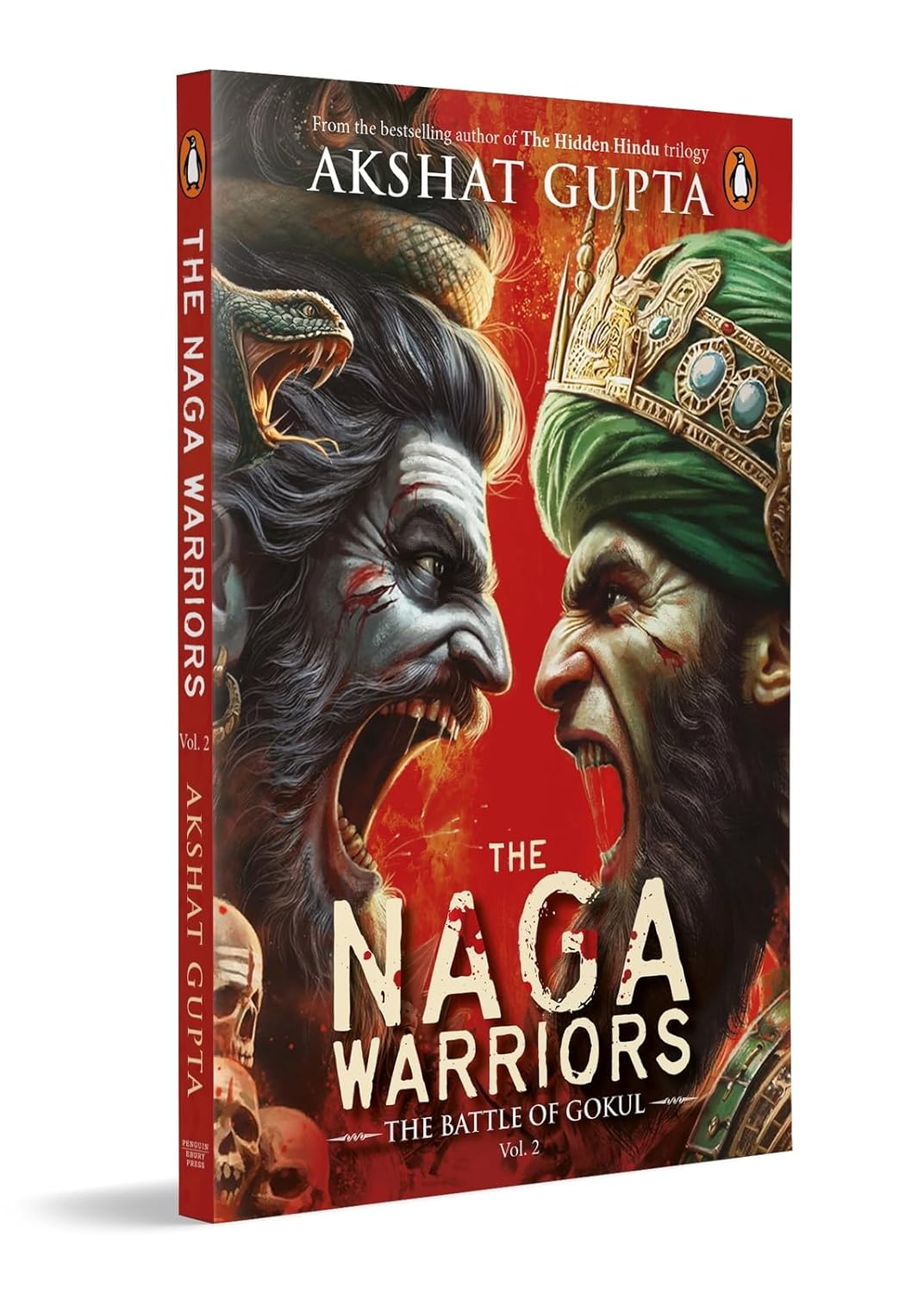The Naga Warriors: Battle of Gokul Vol 2, published on 24 January 2025, is a breathtaking continuation of Akshat Gupta’s bestselling saga, diving deeper into a world where myth, history, and destiny collide. This second volume of the duology begins where the first left off plunging readers back into the mystical and dangerous world of the Nagas, ancient warrior beings who exist in the shadows of civilization, guarding sacred truths and hidden powers.

At the centre of this thrilling tale is the enigmatic nameless Naga, a figure cloaked in mystery whose journey uncovers secrets long buried beneath time and war. As the brutal Afghan forces led by Ahmad Shah Abdali descend upon Gokul, the stakes rise, not only in the fields of battle but within the hearts of those who choose to defend Dharma. Picking up the threads left in the first volumeof The Naga Warriors; the story unravels long-held mysteries: Who is the nameless Naga? What became of the eighteen sadhus and sadhvis who fearlessly opposed the invaders? Where does Krishna’s unshakable devotion lead him in the chaos of conflict? And what ancient knowledge does the mysterious Adhiraj hold that could tip the scales of war and legacy?
Akshat Gupta in The Naga Warriors masterfully crafts a story where every answer leads to more questions, and each chapter brings new revelations. This is not just a tale of combat instead it is a spiritual war, a test of fidelity, courage, and selflessness. The book explores the emotional and psychological depths of its characters, making the reader feel every dilemma, every betrayal, and every act of valor. The Nagas are portrayed not just as fearsome warriors with supernatural strength and intelligence, but as deeply human in their struggles who are fighting for values, tradition, and an identity rooted in sacrifice.
Blending a rich mythological backdrop with fast-paced action and intricate storytelling, The Naga Warriors delivers an immersive reading experience. The prose is accessible yet atmospheric, pulling readers into a world that feels both ancient and urgently relevant. Whether it is the vivid battle scenes, the quiet moments of introspection, or the layers of suspense, the narrative is structured like a puzzle each piece bringing you closer to an epic truth.
This volume does not just match the intensity of the first instead it surpasses it with deeper themes, more profound questions, and a storyline that challenges both the characters and readers to reflect on what it truly means to protect a legacy. For anyone fascinated by Indian mythology, powerful characters, and stories that intertwine faith with fearless action, The Naga Warriors is an absolute must-read.
Read Also: Caste Pride: Battles for Equality by Manoj Mitta
Book Availability, Formats, and Pricing

The Naga Warriors: Battle of Gokul Vol 2 by Akshat Gupta, the bestselling author of the Hidden Hindu Trilogy, is now available for readers in India. Published on 24 January 2025 by Penguin eBury Press, this book is written in English and comes in multiple formats to suit every reader’s preference. The paperback edition is priced at ₹227 and contains 336 pages, making it a detailed and immersive read. The Kindle edition is available for ₹200, perfect for digital readers, while the audiobook version is currently available for free (₹0), making it accessible for those who enjoy listening to stories.
You can purchase The Naga Warriors Vol 2 from popular online platforms such as Amazon India, Flipkart, and the Kindle Store. The audiobook may also be available on Audible. Be sure to check these platforms for the latest prices, offers, and delivery options.
Read Also: Joothan: A Dalit’s Life by Omprakash Valmiki
Thematic Analysis of The Naga Warriors

- The Cost of Loyalty and Devotion: One of the most prominent themes in The Naga Warriors Vol 2 is the emotional and spiritual price of unshaken loyalty. As the story unfolds in the aftermath of an earlier battle, the Naga sadhus, led by Dhruv and Shamboo Ji, continue their unwavering quest to defend Gokul. Their loyalty to Lord Shiva and their sacred duty is tested as new threats emerge. This loyalty goes beyond battlefield bravery as it becomes a way of life, a spiritual code that compels them to keep fighting even when the odds are impossible. The Naga Warriors shows that true devotion often comes with deep sacrifice, loneliness, and suffering, especially when the war is not just physical, but personal.
- Rebuilding After Destruction: Following the first major confrontation, The Naga Warriors Vol 2 introduces a reflective yet powerful theme: the struggle of rebuilding after loss. With Gokul partially destroyed and the people traumatized, the story emphasizes resilience and hope. Houses are reconstructed, trust is restored, and the warriors prepare once again to defend their land. The beauty of this lies in its reminder that even when torn down, communities rooted in faith and unity can rise again even stronger than before. In The Naga Warriors, the act of rebuilding becomes as heroic as battle itself, symbolizing the unbreakable spirit of those who refuse to surrender to destruction.
- Unfolding of Inner Mysteries and Identities: The Naga Warriors Vol 2 delves deeper into hidden truths and long-held secrets, especially surrounding the nameless Naga, Adhiraj, and Dhruv’s search for the sacred Math. The story thrives on questions: Who truly is the nameless Naga? What deeper wisdom does Adhiraj carry? What secrets lie within the sadhus and the spiritual order they protect? This story discovers hidden truths that shows an important message that the hardest battles are not just fought outside, but also inside a person’s heart. The Naga Warriors uses these revelations to add emotional and mythological weight, driving home the idea that knowledge and self-discovery can be just as dangerous and transformative as battle.
- Fearless Resistance Against Overwhelming Odds: The narrative of The Naga Warriors is powered by the theme of standing strong in the face of unimaginable challenges. With the Afghan army closing in with 30,000 soldiers, 1,900 horses, 1,500 camels, and 70 cannons and the defenders of Gokul must rally their remaining forces and spiritual strength. This theme captures the pulse of the story: a spiritual war fought by a few against many, a battle where devotion outweighs numbers. The warriors’ refusal to back down becomes a testimony to their belief in Dharma and the power of a cause greater than self-preservation. In The Naga Warriors, resistance is not a last resort but it is a sacred duty that defines every warrior’s purpose.
- The Moral Complexity of War and Victory: Unlike traditional tales where good simply triumphs over evil, The Naga Warriors Vol 2 brings a morally complex lens to war. While the warriors fight to protect the divine, not all victories feel like triumphs. As the characters battle physical enemies and internal dilemmas, they begin to realize that each win comes with guilt, grief, and sacrifice. This theme brings emotional depth to The Naga Warriors, reminding readers that no war is ever clean, and even the righteous can suffer from their own decisions. It also suggests that maintaining Dharma is not about easy answers, but hard choices made with courage.
- The Divine in the Ordinary: Throughout The Naga Warriors Vol 2, divinity is not just reserved for gods or avatars as it lives within the ordinary warriors, the villagers, and the silent sacrifices made by common people. This theme brings a grounded holiness to the story, showing how every act of bravery, every prayer, and every choice rooted in righteousness becomes an offering. The story positions the battlefield as a sacred space, and the warriors as extensions of divine will. In The Naga Warriors, the lines between god and man blur, elevating everyday heroism into something eternal and sacred.
- Unbreakable Brotherhood and Warrior Camaraderie: One of the most emotionally resonant themes in The Naga Warriors Vol 2 is the deep bond among the Naga sadhus. Their unity is not just about strategy or war instead it is built on trust, shared pain, and spiritual alignment. Whether it is Dhruv searching for the Math or Shamboo Ji preparing for the final stand, their connection goes beyond words. They are not just comrades in arms; they are spiritual brothers fighting a divine war. This theme highlights how sacred brotherhood can strengthen even the most fatigued soul, and how warriors who fight as one spirit can stand against an army of thousands.
- Resistance as a Form of Spiritual Expression: The Naga Warriors positions resistance not merely as an act of survival but as a higher spiritual expression. The Nagas fight not only to protect Gokul, but to guard the cosmic order and spiritual balance. The very act of fighting becomes a form of worship and every weapon raised is an offering to Shiva, every sacrifice a step toward moksha. This theme elevates the concept of battle, transforming it into a sacred responsibility where war is not for conquest, but for preservation of divine truth.
- Philosophical Depth vs Narrative Flow: An intriguing but occasionally divisive theme in The Naga Warriors is the tension between spiritual exposition and storytelling rhythm. With extended sections on Shiva’s avatars or Hindu rituals, the narrative sometimes pauses for philosophical depth. While this enriches the cultural tradition, it also disrupts pacing as several readers noted, the philosophical digressions felt like tangents. This tension highlights the broader theme: in balancing mythology and momentum, does spiritual depth always enhance the story, or occasionally hinder its visceral impact?
- Emotional Fallout of Endless War: Unlike many mythological tales that focus solely on heroism, The Naga Warriors does not shy away from showing the emotional cost of war. After defeating Sardar Khan’s army, the sadhus rebuild Gokul, only to face another looming threat. The constant pressure of fighting, losing, and rising again wears heavy on their spirits. There are moments of grief, flashbacks of loss, and quiet scenes where warriors reflect on what has already been lost. This emotional depth brings realism to the fantasy, reminding readers that even divine warriors bleed, break, and grieve.
- The Fragility of Victory and the Illusion of Peace: The narrative in The Naga Warriors subtly explores how victory can be fleeting. After the initial win against the Afghan troops, the people of Gokul rebuild their homes and lives but the war is far from over. The looming approach of Abdali’s massive army shows how peace is often an illusion in times of spiritual unrest. This theme underscores a sobering truth: even after one battle ends, another begins. It is a reminder that Dharma must be guarded constantly, not just defended once.
Why This Book Deserves Your Attention: The Naga Warriors
Read Also: How to Love in Sanskrit-Timeless Love Poems
The Naga Warriors stands out because it brings together mythology, history, and action in a way that feels both exciting and meaningful. From the very first page, the story takes you into a world of faith, courage, and mystery. If you love reading about ancient legends and powerful characters, The Naga Warriors is a book you should not miss.
What makes this book even more special is how it shows the emotions of the characters. They are not just warriors but they are people dealing with fear, loss, and tough choices. Their struggles feel real and relatable. In The Naga Warriors, every battle is also a personal fight, which helps you connect with the characters on a deeper level.
The story also gives a beautiful look into India’s culture and spiritual roots. It respects tradition while telling a story that feels modern and powerful. If you enjoy meaningful stories that mix action with ancient beliefs, The Naga Warriors will keep you thinking long after you finish reading.
Final Thoughts
The Naga Warriors is a powerful continuation of a mythological journey that mixes intense action, deep emotions, and spiritual wisdom. With a strong cast of characters, thrilling battle scenes, and thought-provoking themes, the book delivers much more than just a story as it offers an experience. Whether you are drawn to stories of courage, faith, or ancient India’s rich traditions, this book offers something for every reader.
Akshat Gupta has once again proved his strength in storytelling by creating a world where legends feel real and every choice carries weight. While some parts may feel slower or more detailed, the overall journey is rewarding and full of meaning. For fans of mythological fiction, historical adventures, and emotionally rich narratives, The Naga Warriors is a must-read that stays with you long after the final page.




